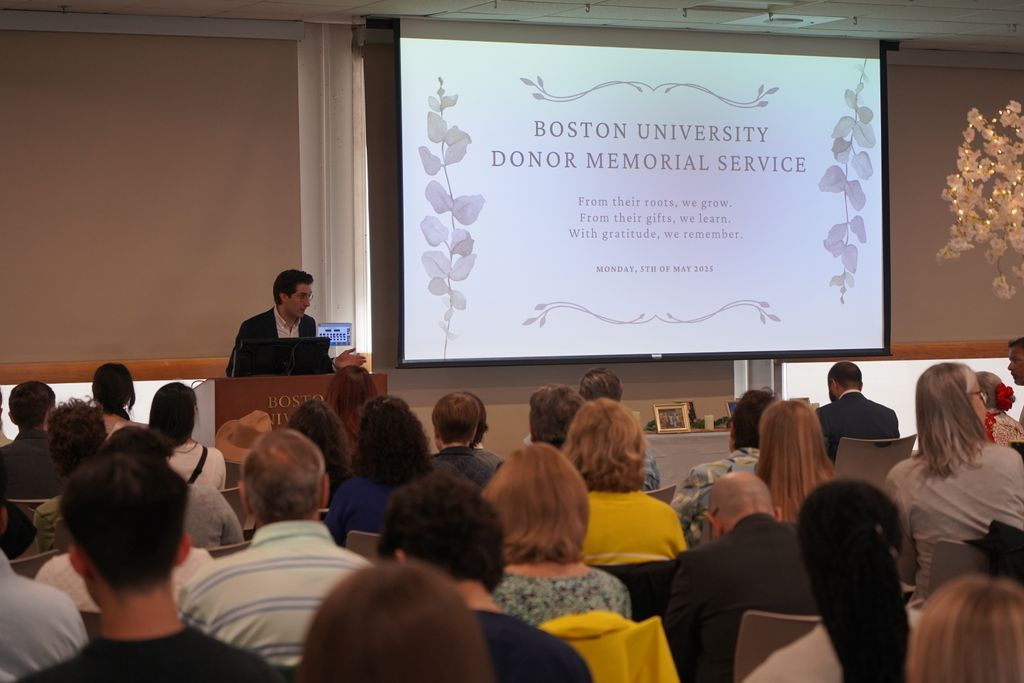Annual Memorial Service Honors Anatomy Donors
Katie Gorman did not expect to cry at the ceremony, but when first-year medical student Gabrielle Ruban sang “Moon River,” the tears came.
Her mother, Mary Gorman, was one of 31 anatomical gift donors honored by medical and dental students at the annual memorial service for anatomy donors held May 5 in Hiebert Lounge. Nearly 200 people attended the memorial service and as Gorman looked around the room, especially at the nearly 90 family members representing 20 of the donors, she thought of them as being united in loss, but also in noble sacrifice.
The musical performances and heartfelt speeches by students touched her.
“They talked about the bodies of the donors so respectfully, and everybody said ‘thank you, thank you,’” said Gorman, who attended with her sister Anne Richards and other family members. After the ceremony, she met three first-year dental students who directly benefited from her mother’s sacrifice.
“It really is your first exposure to the human body, to working on a person, and the entire time you are so grateful for what they (the donors) are providing to us, and it really increases your empathy and your respect for them,” said first-year dental student Nicole Kenda. Students learn one aspect the life history of a donor in how the body reflects physical stress, dietary habits, diseases and injuries.
 L-R First-year dental student Carolina Meza talks with fellow first-year dental student Nicole Kenda and Katie Gorman, whose mother Mary Gorman was an anatomical donor.
L-R First-year dental student Carolina Meza talks with fellow first-year dental student Nicole Kenda and Katie Gorman, whose mother Mary Gorman was an anatomical donor.
The memorial service with photos of the donors and the opportunity to meet family members reveals their personal and family history.
“It was really very rewarding and emotional, too, because we know different aspects of the person,” said first-year dental student Purnima Sainani, who spoke with donor families following her performance on the piano playing three short compositions.
The event united families and students in paying tribute to the donors.
I told them that there’s nothing that can replace what we learn from an actual person, and that their family member meant a lot to us.
First-year medical student Sydni Britton
“We’re all here for the same reason. It’s really beautiful,” she said.
First-year medical student Sydni Britton was intimidated at first by the Gross Anatomy Lab and the donor bodies. But her interest in learning overcame her initial fear.
“When you understand what you’re doing, what you are there to do, it is more humbling than scary,” said Britton, who spoke with donor families after the service.
“I told them that there’s nothing that can replace what we learn from an actual person, and that their family member meant a lot to us,” Britton said.
Britton spoke with members of the McCormack family who were there to honor Henry McCormack, Jr., a graphic artist with a dry sense of humor, according to his niece Charlotte McCormack.
The students I spoke with were very open about how they worked with the donors, how important it was for them to actually see things they’d only actually seen in textbooks, that the value it brought them as students was tangible.
Donor family member Charlotte McCormack
“The students I spoke with were very open about how they worked with the donors, how important it was for them to actually see things they’d only actually seen in textbooks, that the value it brought them as students was tangible,” Charlotte McCormack said. “They were very gracious and extremely appreciative of the families and the donors.”
Charles Brent Harold was a radical, said wife Susan Weegar. “He was willing to speak up and say what he thought.” A former English professor, newspaper columnist and author, Harold was in love with learning new things, like playing the banjo, building a house and sailing. Weegar said that Robert Bouchie, the anatomy lab manager and director of the anatomical gift program, and others in the program set the tone that donors, like patients, were to be treated with dignity, respect and care.
“It’s a good feeling for you as a survivor to know that,” she said.
The Kelleher family felt the same way. Joyce Kelleher’s mother Marjorie, who passed away last year, donated her body, and the extended family was present to honor their father John, who also had donated his body.
 Master of ceremonies Stuart Sommers, a first-year medical student addresses a full house at the event.
Master of ceremonies Stuart Sommers, a first-year medical student addresses a full house at the event.
“My mother talked about doing it for 34 years,” Kelleher recalled. The program and service inspired her brother to donate his body, and Kelleher has taken out the paperwork to do the same.
“I just think this (anatomy) program is incredibly well-run,” said first-year medical student Stuart Sommers. “Throughout the program there were many reminders that the donors are human beings, with life stories, of how much more they were beyond their body.”
He recalled talking to one family who said their family member had run away to Las Vegas at age 14 and took his grandfather’s name.
“I was very impressed by the courage that it took to do that, and it was such an interesting back story,” said Sommers, who volunteered to be master of ceremonies. He said nearly 50 students signed up for the memorial service committee.
“Each donor has provided us with an incredible gift, one that allowed us to learn, grow and further develop as healthcare professionals and scientists,” said student speaker Ashley Fair, who is pursuing a Master of Science in Anatomy & Neurobiology. “Donors are the silent heroes of science.”